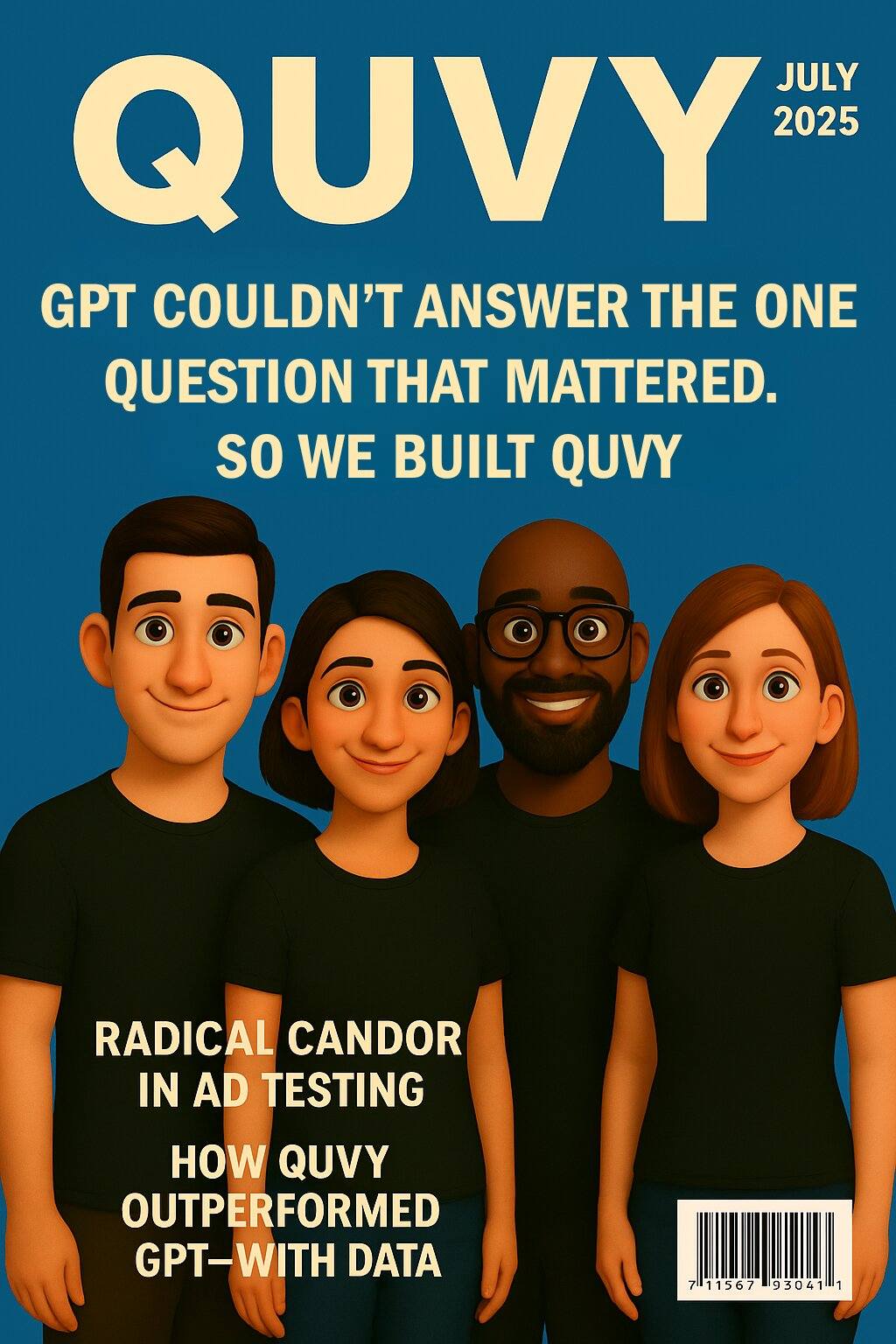
When ChatGPT hit the scene, it felt like a cheat code for marketers.
Suddenly, you could generate 10 ad hooks, 5 email variations, and even landing page copy with a few well-structured prompts. And we’ll admit, we used it, loved it, and still use it for a lot of content ideation.
But there was one major gap that kept nagging at us:
Which version is actually going to perform?
That’s the question ChatGPT couldn’t answer. And it’s the reason we built Quvy with radical candor in mind from day one.
ChatGPT Is a Great Creative Partner, But Not a Performance Tester
Let me be clear: ChatGPT is an incredible tool for idea generation. It helps speed up brainstorming, gives new angles to test, and unlocks creative possibilities we wouldn’t have reached on our own.
But when it comes to making decisions about ad spend, we needed more than ideas. We needed accuracy, something reliable that we could trust when real money was on the line.
That’s when the lightbulb went off: the problem isn’t creative generation. It’s performance prediction.
So we built Quvy, not as a replacement for ChatGPT, but as the tool that steps in where ChatGPT stops.
Because when GPT says, “That’s a great idea!”—Quvy asks, “Will it actually work?”
Accuracy: Where the Numbers Tell the Story
We ran a series of head-to-head tests to see how Quvy stacked up against ChatGPT in terms of prediction accuracy. Here’s what we found:
- Quvy was tested 15 times on a set of 10 ad creatives it had never seen before.
- It achieved a fixed Spearman score of 0.78.
- This means Quvy’s ranking of ads closely matched actual real-world performance data, and it did so consistently every single time.
ChatGPT, on the other hand, told a different story:
- GPT-o3 returned scores ranging from 0.07 to 0.64, with an average of 0.35.
- GPT-4o ranged from 0.07 to 0.42, with an average of 0.27.
Not only were the scores lower, they also varied significantly between runs, even when the input was exactly the same. In other words: you could ask the same question 15 times and get 15 different answers.
That kind of unpredictability might be fine when you're writing copy. But not when you're about to hit “Launch” on a $5,000 campaign.
Consistency: The Power of Determinism
One of Quvy’s biggest advantages is something called determinism.
That simply means: if the input is the same, the result is always the same. No randomness. No guessing. No surprises.
Quvy isn’t here to be nice. It’s here to be right. That’s radical candor by design.
ChatGPT, in contrast, is stochastic—meaning its results involve randomness. It’s more like a conversation partner: useful, fluid, and flexible, but unreliable when precision matters.
If your creative strategy relies on gut feelings, ChatGPT might feel good. But if your budget relies on performance, Quvy gives you something you can trust.
Note: Quvy’s deterministic behavior applies to its core scoring model. Real-time targeting and simulation features that include LLMs may still involve some randomness.
Wasted Spend: The Pain That Sparked It All
Before building Quvy, we launched a campaign using several creative versions written with AI. We picked the best one (in our opinion), ran the campaign, and watched our CPC climb while conversions stayed flat.
Later, we ran that same batch through an early prototype of Quvy.
The version we had picked? One of the lowest-ranked by predicted performance.
The version we didn’t use? It scored in the top 2%.
That experience, how common it is, how painful it can be, is exactly what drove us to focus on this:
Marketers don’t need more ads. They need better ones.
And better starts with brutal honesty, not polite feedback.
Quvy Was Built for This One Job
That’s the core difference.
ChatGPT is general-purpose. Quvy is purpose-built.
It’s not here to write your copy, build your funnels, or talk you into anything. It does one thing better than anything else:
Tell you which ads are likely to win before you spend money running them.
We do that by simulating performance using real ad account patterns, historical outcomes, and structured predictive models. And we show you not just a score, but how your creative stacks up against alternatives.
So… Why Quvy, If ChatGPT Exists?
Because when you’re making real decisions with real money, you don’t want a chatbot.
You want a tool that won’t flatter you, won’t guess, and won’t hold back.
You want radical candor backed by data.
You want Quvy.
Test Setup Summary (For Transparency)
- Date: May–June 2025
- Ad Set: 10 static ad creatives (excluded from training)
- Models Tested: Quvy, GPT-o3, GPT-4o
- Runs Per Model: 15
- Metric: Spearman rank correlation
- Purpose: Measure how consistently each model ranked creatives compared to real-world outcomes
Ready to See the Difference?
We built Quvy to be fast, easy, and useful, even if you’re not a math nerd or media buyer.
If you’ve got ads to test, give it a try:
Stop guessing. Start testing.